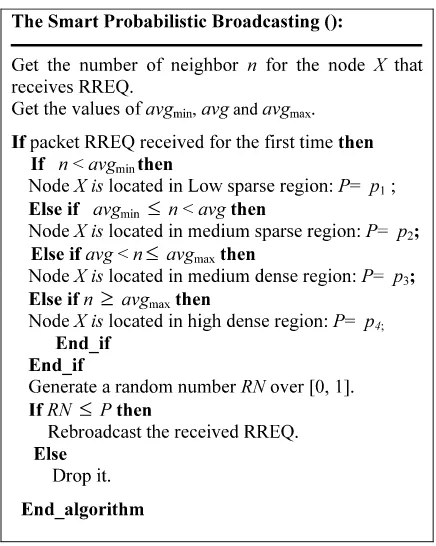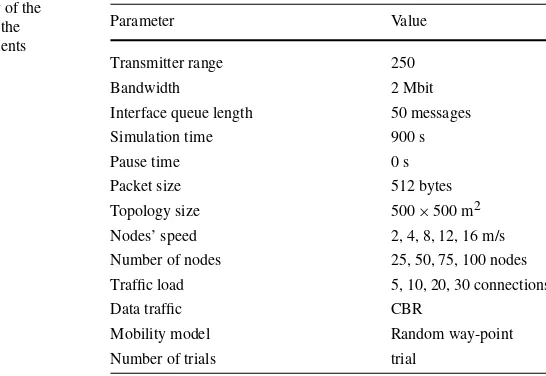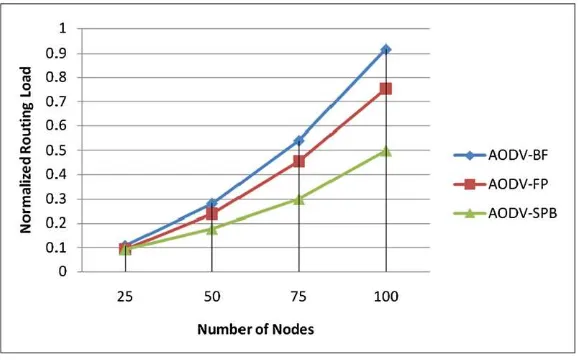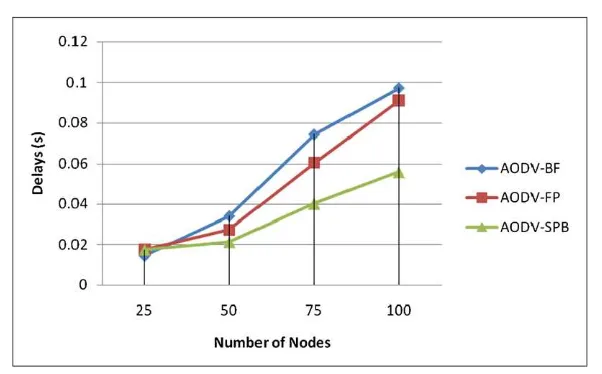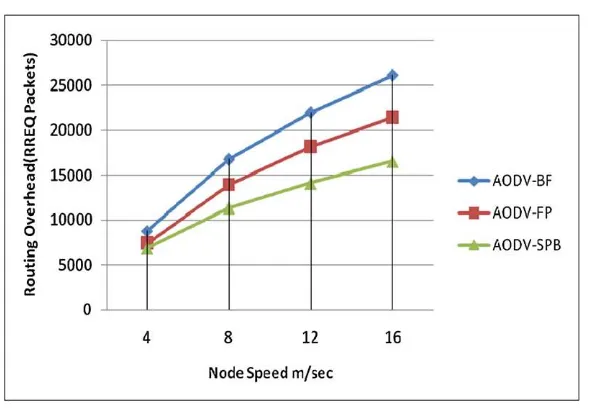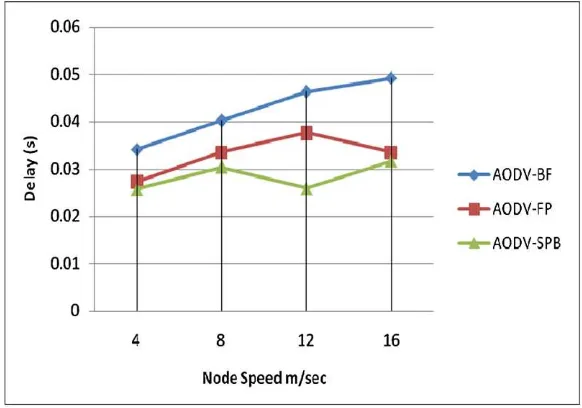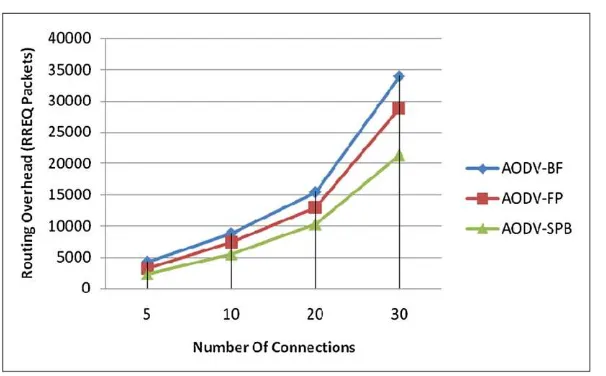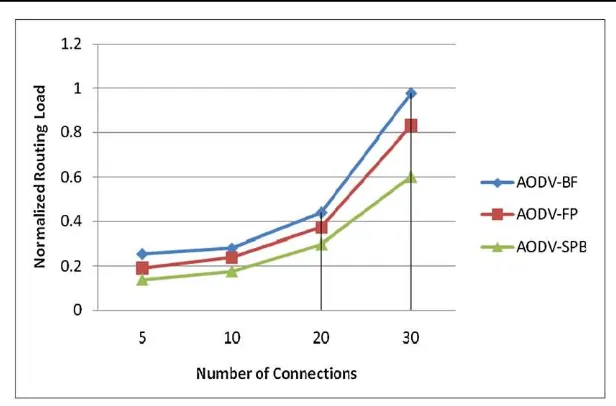DOI 10.1007/s11227-010-0408-0
A new probabilistic broadcasting scheme for mobile ad
hoc on-demand distance vector (AODV) routed
networks
Muneer Bani Yassein·Mustafa Bani Khalaf· Ahmed Y. Al-Dubai
Published online: 17 March 2010
© Springer Science+Business Media, LLC 2010
Abstract Broadcast is a fundamental operation used in Mobile Ad hoc NETworks (MANETs) for many services, such as route discovery and sending information mes-sages. The direct method to perform broadcast is a simple flooding, which can de-crease the performance of MANET. Recently, a probabilistic approach to flooding has been proposed as one of most important suggested solutions to solve the broad-cast storm problem, which leads to the collision, contention and duplicated messages. This paper presents the Smart Probabilistic Broadcasting (SPB) as a new probabilis-tic method to improve the performance of existing on-demand routing protocols by reducing the RREQ overhead during the rout discovery operation. The simulation re-sults show that the combination of AODV and a suitable probabilistic rout discovery can reduce the average end-to-end delay as well as overhead, while achieving low nor-malized routing load, compared to AODV that uses fixed probability and blind flood-ing. Simulation experiments have been conducted to examine our proposed scheme. The results show that SPB outperforms its counterparts and opens up a promising framework towards optimal probabilistic broadcasting.
Keywords MANET·Routing overhead·Flooding·Simulation·AODV
M. Bani Yassein·M. Bani Khalaf
Dept. Computer Science, Jordan University of Science and Technology, Irbid 22110, Jordan M. Bani Yassein
e-mail:[email protected]
M. Bani Khalaf
e-mail:[email protected]
A.Y. Al-Dubai (
)
1 Introduction
Broadcast communication, in which a source node sends the same message to the remaining nodes in the network, is one of the most useful collective communication operations. Due to its extensive use, efficient broadcasting is critical to the overall performance of distributed systems. For instance, broadcasting is frequently used by many important applications such as search, discovering unicast routes between a source and a destination, data movement, and graph algorithms. Furthermore, broad-casting is fundamental to the implementation of higher-level communication opera-tions such as gossip, gather, and barrier synchronization that utilize broadcasting as a building block, providing important control and route establishment functionality. Ensuring a scalable implementation of a wide variety of distributed applications ne-cessitates efficient implementation of broadcast communication. Thus, any improve-ments to the broadcast communication can be immediately realized by higher-level MANET functionality and applications [1].
The Mobile Ad hoc NETwork (MANET) is a collection of wireless mobile de-vices, where transferring data between them is done by intermediate devices inde-pendently from any base station. MANETs are self-organizing/configuring mobile wireless networks that do not rely on a pre-existing infrastructure to communicate. The mobile nodes are connected by wireless links with arbitrary movements, thus leading to unpredictable topologies. In MANETs, nodes have limited transmission range, and packets may need to traverse multiple other nodes before reaching their destination. Research on MANETs was initiated three decades ago by DARPA for packet radio projects [2]. Nowadays, research in this field regained popularity due to the widespread availability of different portable wireless devices such as cell phones, PDAs and WiFi/Bluetooth enabled laptops [3].
Broadcasting scheme is a basic procedure used to send out information messages between mobile devices in MANET, and it is also the basic method for many pro-tocols like Dynamic Source Router (DSR) [4] and AODV [5]. Although the broad-casting scheme is presumable to distribute messages between all nodes, it has several problems that decrease efficiency and performance in MANETs, such as duplicate transmission, collisions and contention; these problems are calledbroadcast storm problem[6]. In many conventional on-demand routing protocols like AODV [5], a mobile host floods Route REQuest control packets (RREQ) to its surrounding neigh-bors in order to discover a route to explicit destination, then each neighbor rebroad-casts the RREQ control packets until the path between source and required desti-nation is established. Broadcasting has been a fundamental communication pattern in many networked and distributed systems. Specifically, due to the ever-changing topology, broadcast communication is essential to MANETs. The common approach for broadcasting is performed through flooding, which is well suited for MANETs as there is no need for topological knowledge. Despite the fact that flooding can be per-formed straightforward in MANETs, flooding is still a problematic issue and far from optimality as it generates high member of redundant messages, collisions, contentions and wasting valuable limited resources such as bandwidth and energy supplies [2].
approach requires complete topology information to achieve optimal results. How-ever, in MANETs, the availability of complete topology information that lasts for reasonable periods is unrealistic. Consequently, the probabilistic approach where a mobile host will rebroadcast a broadcast message that was received for the first time with a probabilitypand takes no action with probability 1−p, has been an efficient scheme for handling broadcasting in MAMETs. Studies [6] have shown that prob-abilistic broadcasts incur significantly lower overhead compared to blind flooding while maintaining a high degree of propagation for the broadcast messages.
Recently, a number of probabilistic approaches to flooding have been proposed to solve the broadcast storm problem [6–9]. In the conventional probabilistic scheme, the mobile host will rebroadcast a broadcast message which is received for the first time with probabilityp. In this scheme, the rebroadcast decision is made without any information about the network topology and the surrounding node neighbors. This paper proposes new route discovery algorithms, namely Smart Probabilistic Broad-casting (SPB) that enhances probabilistic broadcast methods to propagate the RREQ packets. To evaluate the SPB method we have used the AODV routing algorithm. Our results show that the idea of implementing AODV with SPB helps to reduce the overall routing overhead with improved end-to-end delay when compared against the traditional AODV.
The rest of the paper is organized as follows. Section2 presents related work on some route discovery techniques. Section 3 presents the effect of using differ-ent random waypoint models on the number of neighbors. Section4presents Smart Probabilistic Broadcast mechanism (SPB). Section5shows the performance evalua-tion. Finally, Section6concludes this study and outlines some directions for future research work.
2 Related work
The direct method which uses broadcasting is flooding, where every mobile host receives a broadcast message and retransmits it to all nodes in network if it is re-ceived for the first time. In [4], the authors have studied different methods proposed to solve the broadcast storm problem, for example, blind flooding, probability-based, distance-based, counter-based, and location-based and neighbor knowledge schemes. In [10] Q. Zhang and Agrawal implemented dynamic probabilistic broadcasting which combines the advantages of both counter-based and probabilistic methods. This algorithm adjusts the value ofpbased on the value of the packet counter, but it has drawbacks where the decision to rebroadcast is done after a random delay time and the probability decreases or increases according to small constantd which is not explicitly specified.
M. Bani Yassein et al. [8,11] proposed a probabilistic flooding scheme by using multiplep, high, medium, and low. These values set according to the local neigh-bors’ information. This improving applied over the pure broadcasting, in terms of
reachabilityandsaved rebroadcast.
into four groups according to their neighborhood information. For each group, there is a specified value of probability, so the nodes with more neighbors are given higher probability while the nodes with fewer neighbors are given lower probability [12].
Cartigny and Simplot [13] proposed an algorithm which combines the advantages of both probabilistic and distance methods to privilege the retransmission by nodes that are located at the radio border of the sender. The value of probabilitypis deter-mined by the information collected from the node neighbors and the constant value K, which is an efficiency parameter, set to achieve high reachability.
In [14], the authors proposed an adaptive counter-based scheme in which each node dynamically adjusts its threshold valueC based on local neighbors’ informa-tion. The fixed thresholdC is computed based on a functionC(n), wheren is the number of neighbors of the node. In this approach, the value ofn can be achieved through periodic exchange of ‘HELLO’ packets among mobile nodes.
In [15], the authors presented efficient broadcasting schemes that combine the ad-vantages of pure probabilistic and counter-based schemes. The rebroadcast decision depends on both fixed counter threshold and forwarding probability values. The value of probability is set according to packet counter that not exactly indicates the number of node neighbors.
Zone Routing Protocol (ZRP) [14] is another technique that was proposed to re-duce RREQ control packets, which uses a combination of two protocols, namely
proactiveandreactive; it takes the advantages of both protocols in order to solve the flooding of RREQ control packets. In case ofproactive, route information is available when it is needed; as a result, a node can immediately send a data packet to a required destination in minor delay before data transmission. On the other hand, in case of re-active, since route formation is not available, a significant delay is produced in order to determine a route. The route discovery procedure in ZRP is established as follows. If the destination is the one inside the zone of the source that is calledInterzone Routing, the source already knows the route to the destination, since the Interzone Routing uses proactive protocols. Otherwise, the source node will be broadcasting RREQ control packets to its peripheral nodes instead of flooding it, since the path between nodes in different zones use reactive protocol.
In [16], the authors introduced a technique to reduce the RREQ overhead during route discovery operation, using the previous path. The authors suggest, when the path between source and destination is changed, that the new path between them will not be extremely different from the previous one. In such a case, the flooding opera-tion for RREQ control packets will be performed only by the new nodes in the new path at maximumkhops. Thekhops is a threshold calculated by the dissimilarities between nodes from old and new paths. However, this technique has disadvantages when applied over a highly dynamic network.
3 The effect of using different system parameters on the number of neighbors
and the topology changes frequently, the density of nodes will be different from low to high levels accordingly. In this paper the forwarding probabilityp will consider this variety of density since the probabilityp will set for different values in dense area (high density indicates thatpwill be low), and also set for different values in sparse one (this meanspwill be high). The node’s neighbor information is the sim-ple approach to decide if a current node is in dense area or not; the information is collected by broadcasting “Hello” packet every second for only one hop. This packet will guarantee for every node to have an updated neighbor list. By using the number of neighbors for each node, the rebroadcast probability will be dynamically adjusted in order to provide a new insight into the trade-off between the values ofp and the node’s surrounding environment.
By extensive simulation study, three values of average numbers of neighbors are determined: the minimum average number of neighbors (avgmin), the average number of neighbors (avg) and the maximum average number of neighbors (avgmax). Definition 1 Let N be the number of nodes in the network; Ni is the number of neighbors for nodeX:
avg=
n i=1Ni
n , (1)
where avg refers to the average number of neighbors for all the nodes in the network. The value of avg is used as a threshold. If the node has neighbors above the avg, it is placed in a denser area where the value of rebroadcast probabilityphas to be low. On the other hand, if the node has neighbors below the avg, it indicates that the node is in a sparser area, so the value of rebroadcast probabilitypis set high. This indication helps to adjust the value of rebroadcast probabilitypfor a given node according to its surrounding neighbors. However, this is not a fair adjustment because all nodes that have neighbors below avg—as well as all nodes that have neighbors above avg—will rebroadcast with the same probability.
Definition 2 Given two sets of nodes,Mmin<avg andMmax>avg, the two average
numbers avgminand avgmaxof neighbors for both sets are computed as follows:
avgmin=
Table1 shows the summary of the avgmin, avg and avg2 number of neighbors at
a node for different nodes’ speeds. The results show that as the speed of nodes is increased, the avgmin, avg and avgmaxnumber of neighbors of the network also
in-creases. This is because the node will visit different neighbors within a short slot of time.
Table 1 The values of avgmin, avg and avgmaxfor different
nodes’ speeds
Speed of Nodes avgmin avg avgmax
4 3 12 21
8 5 13 26
12 7 15 28
16 10 20 31
Table 2 The values of avgmin,
avg and avgmaxfor different
number of nodes
nodes increasing, the avgmin, avg and avgmax number of neighbors of the network
also increases. This is because the larger the number of nodes for a certain network, the higher the possibility to create a dense area. As a result, the number of neighbors for a given node will increase.
4 Smart probabilistic broadcasting
In the traditional AODV [5], all RREQ packets that have been received for the first time will be flooded by the intermediate node. If the intermediate node does not have a valid route to destination, andN is the total nodes in the network, the number of possible broadcasts of an RREQ packet in AODV isN−2 (the source and destination will not retransmit a received RREQ that is being generated) [17].
A brief outline of the AODV-SPB is shown in Fig. 1. When hearing a broad-cast RREQ packet at nodeX for the first time, the node compares its neighbor by avgmin, avg and avgmax: if the node has a number of neighborsnless than avgmin,
this implies that the node is in a low sparse region. Then, the node rebroadcasts the packet according to probability p1. However, the probability p2 is selected if the
number of neighborsnsatisfies avgmax≤n <avg: this implies that the node is in a
medium sparse region. Otherwise, the value of probabilityp3 is chosen if the node
is in a medium density region and the number of neighborsnmeets this condition: avg≤n <avgmax. Finally, the value of probability p4 is chosen if the number of
neighborsnisn≥avgmax: this implies that the node is in a high density region.
Fig. 1 Description of the SPB algorithm
rebroadcasts of an RREQ packetNbusing the SPB algorithms is:
Nb=
4
i=1
piNi for the SPB-AODV, (4)
whereNi is the number of nodes that chosepi. IfN is the total number of nodes in the network, then the total number of rebroadcasts of an RREQ packet in SPB-AODV, AODV-FP and AODV-BF is respectively related as follows [17]:
Nb=
4
i=1
piNi< p×(N−2) < N−2. (5)
The value of the fixed probability used in AODV-FP is set atp=0.7. This is because [7,8] have shown that this probability value enables the fixed probabilistic flooding to achieve a good performance.
5 Performance analysis
Table 3 Summary of the Number of nodes 25, 50, 75, 100 nodes Traffic load 5, 10, 20, 30 connections
Data traffic CBR
Mobility model Random way-point
Number of trials trial
TCP, routing, and multicast protocols over wired and wireless networks. The simu-lation scenarios consist of different mobile nodes moving in different network areas; each node has a 250-meter transmission range and a bandwidth of 2 Mbps. Each data point in the simulation results represents an average of 30 randomly generated mo-bility patterns in order to achieve a 95% confidence interval in the collected statistics. The MAC layer protocol is IEEE 802.11 [19]. The nodes move according to the ran-dom waypoint model. This mobility model is used to simulate 30 topologies. The speed varies from 2 to 16 m/s with the pause time of 0 s. The main parameters used in the simulations are summarized in Table3.
The simulation scenarios consist of four different settings, each specifically de-signed to assess the impact of a particular network operating condition on the per-formance of the protocols. First, the impact of network density or size is assessed by deploying 25, 50, 75 and 100 mobile nodes over a flat space of a fixed size 500 m by 500 m. The second simulation scenario investigates the effect of an offered load on the performance of the routing protocols by varying the number of source destination pairs (flows, for short) over the range of 5,10, . . . ,30 flows for each simulation sce-nario. The last set of simulations evaluates the performance impact of node mobility by varying the maximum node speed of 100 mobile nodes over the range of 2, 4, 8, 12, 16 m/s in a fixed area of 500 m×500 m. Each flow of constant bit rate (CBR) data, which is used in many previous studies, generates data packets at the rate of 4 packets/s. The packet size is set at 512 bytes.
5.1 Effect of network density
This section presents the performance impact of network density on AODV-BF, AODV-FB, AODV-SPB, over different number of nodes. The network density has been varied by deploying 25, 50, 75 and 100 nodes over a fixed area of 500 m×
Fig. 2 Routing overhead vs. number of nodes placed over 500 m×500 m
Fig. 3 Normalized routing load vs. number of nodes placed over 500 m×500 m
Fig. 4 Delay vs. number of nodes placed over 500 m×500 m
Normalized routing load Normalized routing load measures the percentage of route discovery packets (that are used in finding a route) per data packet delivered to the destination. Figure3demonstrates the effect of network density on the performance of all three protocols in terms of normalized routing load. The AODV-SPB has su-perior performance over AODV-BF and AODV-FP. For more clarity, at high network density (e.g. 100 nodes) the normalized routing loads for the three protocols AODV-SPB, AODV-FB and AODV-BF are equal to 0.5, 0.7 and 0.9, respectively.
End-to-end delay The results in Fig.4represent the average end-to-end packet de-lay. In this paper, they are defined as the average time difference between when a unicast data packet was initially sent by the source node and when it was success-fully received at the destination. The figure reveals the average end-to-end delays incurred by all three protocols. When network density increases, the number of du-plicated RREQ packets which are generated by nodes increases as well, thus leading to the increase of a number of the dropped packets. As a result, packets experience high latencies in the interface queues.
5.2 Effect of network mobility
This section demonstrates the effect of node mobility on the performance of the three protocols. In this study, 50 nodes are placed over 500 m×500 m with each node moving according to the random waypoint mobility model with a maximum node speed of maxV. The node mobility is varied by changing the value of max V. For each simulation scenario, 10 identical randomly selected source destination connections are used.
Fig. 5 Routing overhead vs. node speed for a networksize of 50 nodes and 10 connections
their destinations. In such circumstances more RREQ packets are generated and re-transmitted, which leads to a higher chance of collision due to the increase of control packets. For instance, the AODV-SPB perform better than AODV-FB and AODV-BF by reducing the overhead from around 45%, when compared against AODV-FB and AODV-BF at relatively high node mobility (e.g. 16 m/s) respectively.
Normalized routing load Figure 6 depicts the network normalized routing load achieved by the three routing protocols against the maximum node speed. The figure shows that the network normalized routing load achieved by the protocols increased with increasing the node mobility. This is due to the fact that when the node mobility is increased, the frequency of topology changes is also increased. This can potentially trigger more new route maintenance processes, resulting from the broken routes. As a consequence, larger numbers of RREQ packets are generated and disseminated. AODV-SPB has a higher performance over AODV-FB and AODV-BF.
End-to-end delay Figure7depicts the end-to-end delay of data packets in the three routing protocols for different nodes’ speed. The figure shows that when nodes’ speed increases, the end-to-end delay of data packets also increases. This is because the paths between sources and required destinations frequently changed and established. As a result, the waiting time for data packets in interface queue is increased. How-ever, among all maximum node speeds the AODV-SPB performs better, followed by AODV-FP and AODV-BF.
5.3 Effect of offered traffic load
AODV-Fig. 6 Normalized routing load vs. node speed for a network size of 50 nodes and 10 connections
Fig. 7 Delay vs. node speed for a network size of 50 nodes and 10 connections
SPB, AODV-FB and AODV-BF, where the offered load is varied by increasing the number of source–destination pairs (flows) from 5 to 30.
The topology for each simulation scenario consists of 50 nodes placed randomly on a flat area of 500 m×500 m, moving with the random waypoint mobility with speed between 0 and 2 m/s.
Fig. 8 Routing overhead vs. traffic for a network size of 50 nodes with node speed of 2 m/s
in the figure, the AODV-SPB incurs a lower routing overhead compared to AODV-BF and AODV-FP. For instance, at a heavy traffic load (e.g. 30 connections) the generated overhead is reduced by around 15,000 and 5000 when AODV-SP and AODV-FB are used, respectively. This performance behavior is expected since increasing the offered load leads to an increase in the number of source nodes that initiate route discovery operations.
Normalized routing load Figure 9 reports the results of the network normalized routing load versus offered load for all the three routing protocols. It can be seen in the figure that the normalized routing load achieved by the three protocols increased as the offered load increases. The figure also shows that the performance difference of the three routing protocols becomes more noticeable when the offered load is in-creased. This is because at high offered loads, most of the generated data packets are dropped resulting from collisions and channel contention caused by a high congestion level. For example, when the traffic load increased form 5 to 30 flows, AODV-SPB has a clear performance over AODV-FP and AODV-BF.
Fig. 9 Normalized routing load vs. traffic for a network size of 50 nodes with node speed of 2 m/s
Fig. 10 Delay vs. traffic for a network size of 50 nodes with node speed of 2 m/s
6 Conclusions and future work
broad-cast storm problem, which leads to the collision, contention and duplicated messages. This paper presents the Smart Probabilistic Broadcasting (SPB) as a new probabilis-tic method to improve the performance of existing on-demand routing protocols by reducing the RREQ overhead during the rout discovery operation. The simulation re-sults show that a new smart probabilistic blind flooding algorithm, AODV-SPB, has superior performance over the conventional BF and FP. The AODV-SPB generates much lower routing overhead and end-to-end delay. As a consequence, the packet collisions and contention in the network are reduced. The results have also shown that although the traffic load increased, the normalized routing load is still low. As a continuation of this research in the future, we plan firstly to combine our al-gorithm with different routing protocols, if a combined performance improvement is feasible. Secondly, we aim to propose a highly adjusted probabilistic flooding algo-rithm approach in order to facilitate the exploration of the optimal adaptation strategy. Moreover, we intend to design an analytic model for our dynamic probabilistic ap-proach in order to facilitate the exploration of the optimal adaptation strategy.
References
1. Williams B, Camp T (2002) Comparison of broadcasting techniques for mobile ad hoc networks. In: MOBIHOC, pp 194–205
2. Sasson Y, Cavin D, Schiper A (1987) Probabilistic broadcast for flooding in wireless mobile ad hoc networks. Swiss Federal Institute of Technology (EPFL), Technical Report IC/2002/54
3. Jubin J, Tornow JD (1987) The DARPA packet radio network protocol. In: Proceedings of the IEEE, pp 21–32
4. Johnson D, Hu Y, Maltz D (2007) The dynamic source routing protocol (DSR).
http://www.ietf.org/rfc/rfc4728.txt. Accessed December 2007
5. Perkins C, Belding-Royer E, Das S (2007) Ad hoc on-demand distance vector (AODV) routing.
http://www.ietf.org/rfc/rfc3561.txt. Accessed October 2007
6. Ni S-Y, Tseng Y-C, Chen Y-S, Sheu J-P (2002) The broadcast storm problem in mobile ad hoc net-works. In: Proceedings of the 5th annual ACM/IEEE international conference on mobile computing and networking, pp 152–162
7. Bani-Yassein M, Ould-Khaoua M, Mackenzei LM, Papanastasiou S (2006) Performance analysis of adjusted probabilistic broadcasting in mobile ad hoc networks. Int J Wireless Inf Netw 127–140 8. Sasson Y, Schiper A (2003) Probabilistic broadcast for flooding in wireless mobile ad hoc networks.
In: Proceedings of IEEE wireless communications and networking conference
9. Bani Yassein M, Bani Khalaf M (2009) Performance evolution of multiple probabilities of ad hoc on demand distance vector protocol (AODV). In: Proceedings of the 4th international conference on information technology
10. Zhang Q, Agrawal DP (2005) Dynamic probabilistic broadcasting in MANETs. J Parallel Distrib Comput 220–233
11. Yassein B, Ould-Khaoua M, Papanastasiou SM (2005) On the performance of probabilistic flooding in mobile ad hoc networks. In: Proceedings of 1st int workshop on performance modelling in wired, wireless, mobile networking and computing, held in conjunction with ICPADS
12. Zhang Q, Agrawal DP (2004) Analysis of leveled probabilistic routing in mobile ad hoc networks. In: Proceedings of the IEEE international conference on communications, pp 20–24
13. Cartigny J, Simplot D (2003) Border node retransmission based probabilistic broadcast protocols in ad hoc networks. Telecommun Syst 189–204
14. Aminu M, Ould-Khaoua M, Mackenzie LM, Abdulai J (2008) Performance evaluation of an efficient counter-based scheme for mobile ad hoc networks based on realistic mobility model. In: Proceed-ings of the international symposium on performance evaluation of computer and telecommunication systems, Edinburgh, UK. IEEE, New York, pp 181–188
16. Castañeda R, Das SR (1999) Query localization techniques for on-demand routing protocols in ad hoc networks. In: Proceedings of the 5th annual ACM/IEEE international conference on mobile computing and networking, pp 186–194
17. Abdulai J, Ould-Khaoua M, Mackenzie LM (2008) Adjusted probabilistic route discovery in mobile ad hoc networks. J Comput Elect Eng 168–182
18. The network simulator Ns-2-the VINT pro.http://www.isi.edu/nsnam/ns/ns-build.html. Accessed De-cember 2007
19. Colagrosso MD (2007) Intelligent broadcasting in mobile ad hoc networks: Three classes of adaptive protocols.EURASIP. J Wireless Commun Netw 1–16
